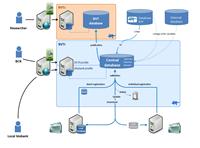Dataflow
Registration of data
Processing of data
Access of data for researchers
Three steps are necessary to allow cancer researchers to trace tumour samples to the tumourbanks involved in the project:
1. Local biobanks (or tumourbanks) need to register data regarding the tumour samples - which are stored locally - in a central database.
2. The BCR needs to process these data and publish the data in the coded database of the Belgian Virtual Tumourbank.
3. Researchers need to query the database of the Belgian Virtual Tumourbank via an electronic tool, which is called the catalogue of the Belgian Virtual Tumourbank. Once the researcher has found the samples he's interested in, he can trace the samples and contact the local biobanks involved.

Concept and dataflow of the
Belgian virtual tumourbank.
Click to enlarge.
Top
1. Registration of data by the local biobanks
Local biobanks store tumour samples, together with relevant clinical and technical data regarding these samples (e.g. type of tumour, freezing temperature, ...). The steering committee determined a standard set of variables which need to be available in the Belgian Virtual Tumourbank. These variables need to be registered by the local biobanks. Therefore local biobanks send their data to the central database at the BCR. Samples are registered via an online web application (called the BVTr or the registration module of the Belgian Virtual Tumourbank). Because these data involve medical data, access and usage of this application takes place in a highly secured way via the User and Access Management (UAM) of eHealth.
The biobank manager making the registration also needs to declare for every single registration that no opposition was made by the patient involved against the usage of his residual samples for scientific research purposes, as determined by the law of December 19th, 2008.
Top
2. Processing of data by the BCR
Once data are registered in the central database, the BCR will validate and code these data and subsequently publish them in the database of the Belgian Virtual Tumourbank. By linking the data to the data from the database of the cancer registration, the BCR is capable of adding the cTNM value and perform quality controls on the registered values.
Top
3. Access of data for researchers
Researchers have access to the database of the Belgian Virtual Tumourbank by means of an online web application (called the BVTc or the catalogue module of the Belgian Virtual Tumourbank). Again access and usage of this application takes place in a highly secured way via the User and Access Management (UAM) of eHealth. The web application allows researchers to perform easy to use queries on the available data and find the samples they're interested in. This allows them to contact the laboratories involved to request usage of the samples.
Top